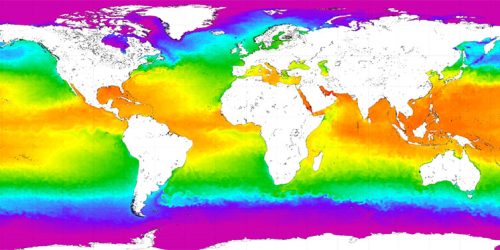In a new study, funded in part by CPO’s Climate Variability & Predictability (CVP) program, Princeton University and Woods Hole Oceanographic Institution (WHOI) scientists discovered that the coastal ocean is an important heat and moisture source for atmospheric rivers in the days before landfall.
Atmospheric rivers—elongated regions in the sky that transport water vapor—deliver up to half of the year’s precipitation and regional water resources in the western United States, and can both alleviate or end the region’s droughts as well as cause extreme streamflow events and flooding. Thus, it’s important to understand the processes that contribute to atmospheric rivers’ intensity. The authors also found that, during El Niño events, the ocean’s heat and moisture input to the atmosphere increases along the southern coast, which corresponds to increased atmospheric river intensity. The study was published as an early online release in the journal of Geophysical Research Letters.
The researchers used observations from buoys, operated by NOAA’s National Data Buoy Center (NDBC) and Integrated Ocean Observing System partners, and the National Ocean Service, to develop a unique view of coastal air-sea exchanges when atmospheric rivers make landfall. They examined near-surface atmospheric and sea surface temperature measurements from 138 over-shelf buoys along the U.S. west coast to analyze variations of latent heat flux (heat exchange that occurs during a phase change, like liquid water to water vapor) during strong late-winter landfalling atmospheric rivers from 1979 to 2017.
Their results reveal several important points about the relationship between nearshore sea surface temperature, latent heat flux, and atmospheric river intensity. Strong, late-winter atmospheric rivers landfalling along the U.S. west coast typically receive the strongest latent heat flux 1-3 days before and after landfall, with latent heat flux reaching its minimum during the first day of landfall. In particular, El Niño winters are associated with increased heat exchange along the southern coast and decreased latent heat flux along the northern coast. Enhanced latent heat flux generally corresponds to intensified atmospheric rivers. The opposite effect is observed for La Niña winters. For seasonal time periods, variations in latent heat flux experienced by atmospheric rivers are primarily controlled by wind speed, relative humidity, and stability. However, over multiple years, sea surface temperature anomalies influenced by the El Niño-Southern Oscillation (ENSO) are the dominant control. The findings suggest a potential role for the coastal ocean in influencing the intensity of landfalling atmospheric rivers.
Photo credit: NOAA National Environmental Satellite, Data, and Information Service (NESDIS)










